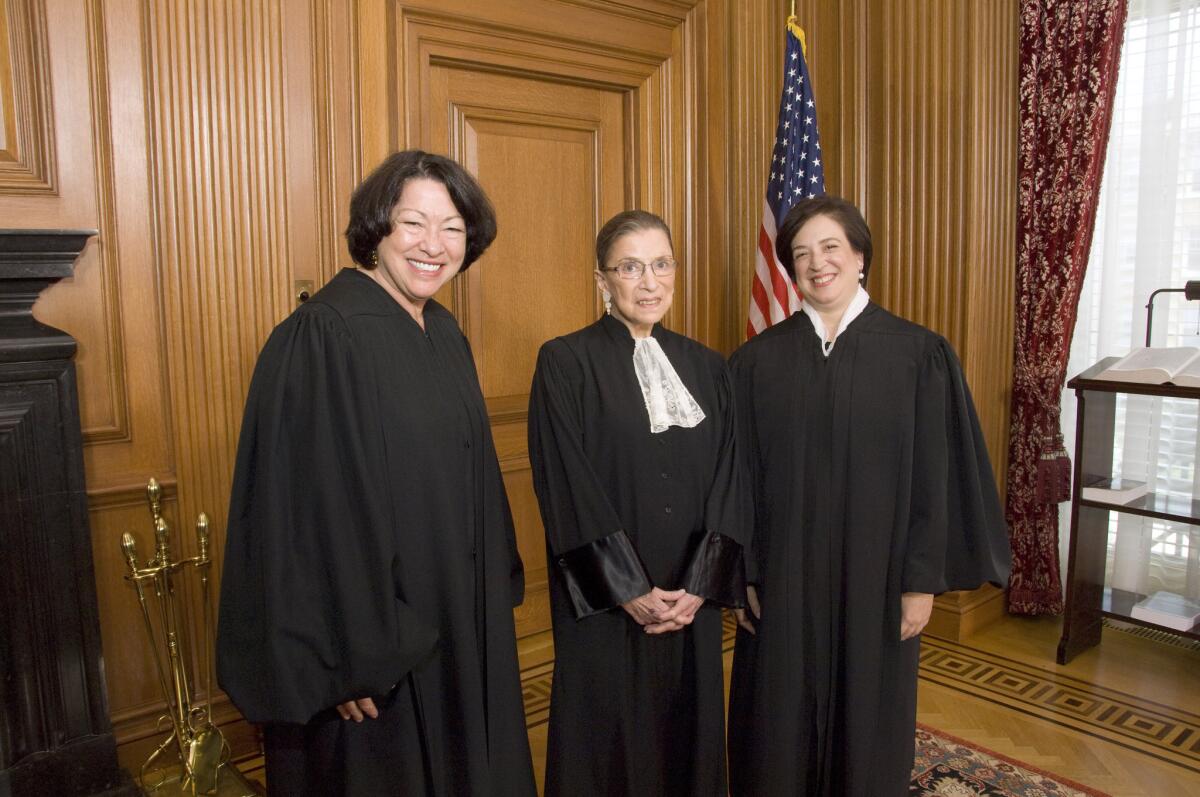Supreme Court on unions: Could have been worse, but still not good

The three horsewomen of the Court’s progressive wing, from left, Justices Sonia Sotomayor, Ruth Bader Ginsburg, and Elena Kagan. All voted in the Harris minority Monday to save union “agency fees.”
Supreme Court Justice Antonin Scalia could have ridden to the rescue of public employee unions in Harris vs. Quinn, the important labor rights case the Court decided Monday, as some scholars thought he might. But he didn’t.
In a 1991 case, Scalia issued a ringing endorsement of the principle of union “agency fees”--payments non-union members make to unions that negotiate their contracts--which were at issue in Harris. (Harris was second-most-anticipated ruling of the day, after the Hobby Lobby birth control case.) In the event, however, he was silent, his name appearing in a couple of places in Justice Samuel Alito’s majority opinion, and once, mischievously, in Justice Elena Kagan’s dissent.
The five-member majority found other grounds on which to decide Harris, so the legality of agency fees isn’t addressed. But the majority hints strongly that they’re not fans of agency fees. That’s bad news for public employee unions and points to further hostility from this court lurking over the horizon.
As we related in a curtain-raiser last month anticipating Monday’s ruling, the roots of Harris vs. Quinn date to 2003, when the Illinois Legislature designated some home healthcare workers public employees and allowed them to organize through the Service Employees International Union. They didn’t have to join the SEIU, but those who didn’t still had to pay the “agency fee” to cover the SEIU’s expenses in negotiating and administering contracts.
That’s a common arrangement in many states, including California. It’s based on the principle that the public employee unions are compelled by law to represent members and non-members alike, so the latter should pay some of the costs of representation.
Agency fees can’t be used to fund political activity, so they don’t infringe on the payers’ free speech rights in cases where the union might be taking political stands the non-members don’t like. They’ve have been upheld by the court since a 1977 precedent-setting decision in Abood vs. Detroit Board of Education.
Abood found that agency fees were the right approach to public employee unions, which in many states are bound by law to represent their members and non-members alike in contract negotiations and grievance cases, among other duties. As Scalia himself wrote in that 1991 ruling, “where the state creates in the nonmembers a legal entitlement from the union, it may compel them to pay the cost.”
In 2010, the Illinois home care law was challenged by a group of workers who argued that being forced to pay anything at all to a union infringed on their free-speech rights. Their cause was taken up by the National Right to Work Legal Defense Foundation, an anti-union group that expanded the case into a broad challenge to the Abood decision and muscled it onto the court’s docket.
If Abood were overturned, the foundation knew, it would deprive public employee unions of their financial lifeblood. This is how a purported free-speech issue became transformed into a bald attack on labor rights.
Alito’s opinion for the 5-4 majority (Scalia concurring) stops well short of overturning Abood. Instead, he rules narrowly that the home care workers in Illinois are not “full-fledged public employees” but hybrids--they’re paid by and subject to the supervision of a state agency, but also subject to the discretion of their home care clients, the patients, who could choose them and “fire” them. They’re not eligible for certain state benefits, like vacation time, retirement or health coverage. Alito finds this sufficient to rule them outside the reach of Abood, and he leaves matters there.
Oddly, however, he goes out of his way to disparage Abood, even after opining that it doesn’t apply. He finds the 37-year-old precedent to be based on “questionable foundations” and asserts, among other points, that it’s difficult in the public sector to distinguish “union expenditures for collective bargaining [which can be covered by agency fees] from those designed for political purposes [which can’t].” But he doesn’t say why it should be so hard--California public employee unions make that sort of accounting all the time.
Alito’s slam against Abood comes under the category of “dicta”--remarks by a judge that have no bearing on the case at hand, though they are clues to his or her innermost feelings. Labor observers found Alito’s remarks disquieting.
“The dicta in Harris about Abood is serious, and it shows that some number of Justices would like to overturn Abood,” writes Benjamin Sachs, a labor law expert at Harvard Law School. In other words, there might be a plurality to overturn Abood, but not a majority. Sounds like a hairsbreadth escape for Abood, this time.
Justice Elena Kagan’s dissent, which was joined by the other liberal justices Sonia Sotomayor, Stephen G. Breyer and Ruth Bader Ginsburg, hints at the intensity of that discussion.
It’s a ringing defense of Abood, which is “not ... ‘something of an anomaly,’” as Alito labeled it, but a rule that is “deeply entrenched, and is the foundation for not tens or hundreds, but thousands of contracts between unions and governments across the nation,” Kagan writes. (She quotes Scalia’s statement from the 1991 case above.)
Kagan contends that the virtues of Abood, which make unions partners with government in keeping public employment stable and maintaining the quality of the public workforce, should be applied to home health workers, where those qualities are desperately needed.
“Workforce shortages and high turnover have long plagued in-home care programs, principally because of low wages and benefits,” she observes. “That labor instability lessens the quality of care, which in turn, forces disabled persons into institutions and (massively) increases costs to the state.” In its zeal to cut into union membership, the majority could “not resist taking potshots at Abood,” she writes.
Implicit in Kagan’s dissent is the question of whose interest the court majority is trying to protect. Not the workers, who lose the support of union bargaining. Not their clients, who must make do with lower-paid and less-trained home care workers. Not the states, which might end up spending more for less.
The victor, if there is one, is the right-to-work movement, which speaks for an ideologically anti-union minority. The Roberts court shows, once again, that it’s the furthest thing one can imagine from a people’s court.
Keep up to date with The Economy Hub by following @hiltzikm.
More to Read
Inside the business of entertainment
The Wide Shot brings you news, analysis and insights on everything from streaming wars to production — and what it all means for the future.
You may occasionally receive promotional content from the Los Angeles Times.











